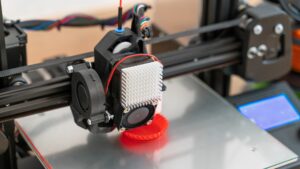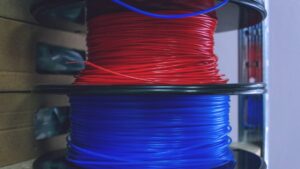
A Look at the Different Densities of 3D Printing Materials
There’s so much to learn about 3D printing materials. Come and find out what to look for when examining the different densities of 3D printing filaments.
844-810-1385
Filaments are the lifeblood of the 3D printing process. These strands of plastic dictate everything about a print, from the required temperature to the finish seen on the final product. This is why it is no surprise that many of the advancements in FDM printing come in the form of advanced filaments. Read on to learn more about the future of 3D printing filaments.
Conductive filaments are among the biggest ideas on everyone’s mind in the 3D printing world. The term “thermally conductive filament” refers to the process of conducting heat through friction or exposure to a heating element. While this may seem counterintuitive to a polymer setting, conductive filaments have a very real role in many different mechanical processes. Some machines use these filaments as a type of emergency brake to slow or stop motion from happening when a machine gets to hot. Others may only use the conductive element as a way to transport heat energy from one area to another.
Another major advancement in the world of filaments is metal polymer mix filaments. These filaments exhibit many of the same properties as regular polymer filaments, except for the fact that these filaments often have a higher tensile strength and will be able to take wear much better. Some of these filaments are even designed to be burnt off in an oven after production, leaving only the metal filament structure behind. While this technology is still in its infancy, this is definitely an area to keep your eye on in the future.
One of the biggest problems faced in 3D printing is the competition with injection molding technology. Simply put, injection molding allows for very tight tolerance polymer shapes, but this method becomes even more valuable as this technology can extend to flexible materials such as rubber. Even so, 3D printing has been trying to keep up and surpass this technology with the advent of more flexible filaments such as TPU 95A. This will undoubtedly change the manufacturing process surrounding flexible objects in the future to make them more accessible to the common consumer.
We hope you have found this overview of the future of 3D printing filaments to be helpful! If you are looking to purchase the latest cutting-edge filaments, such as our glass fiber nylon filament or our TPU 95A, be sure to reach out to Filamatrix today!

There’s so much to learn about 3D printing materials. Come and find out what to look for when examining the different densities of 3D printing filaments.

Those interested in 3D printing have a lot to learn on how to use the system properly. Find out what you need to know about 3D printing and humidity levels.

3D printing has many variables that both beginners and experts need to know. Find out what effects temperature has on 3D printer filament.
Get professional insights, industry news, and our latest deals